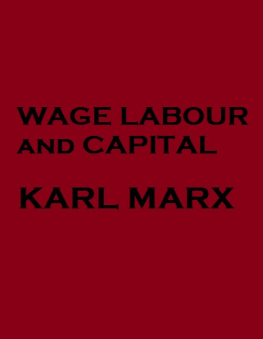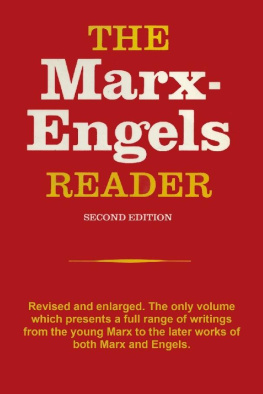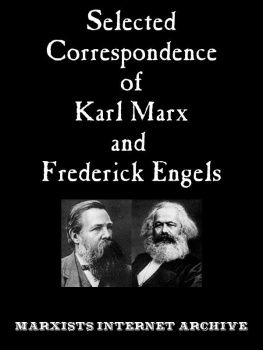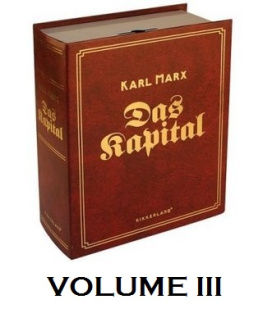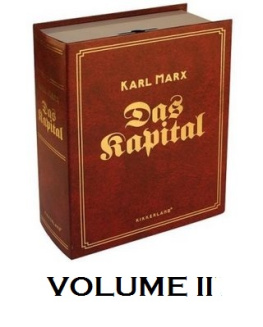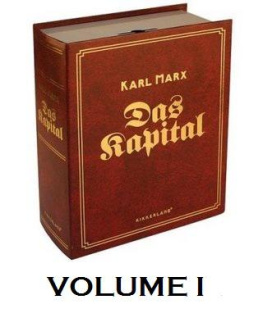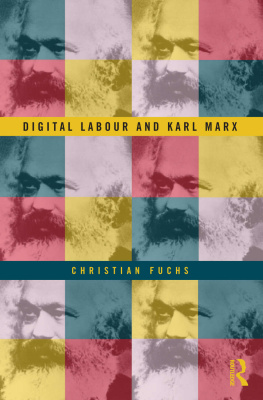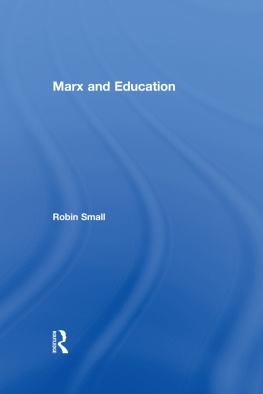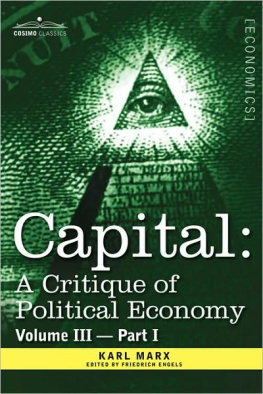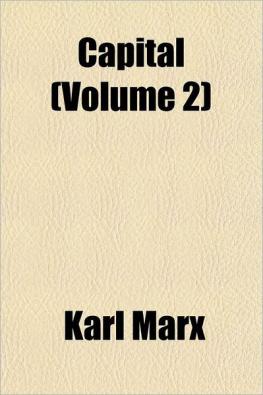Karl Marx - Wage Labour and Capital
Here you can read online Karl Marx - Wage Labour and Capital full text of the book (entire story) in english for free. Download pdf and epub, get meaning, cover and reviews about this ebook. year: 2011, genre: Science. Description of the work, (preface) as well as reviews are available. Best literature library LitArk.com created for fans of good reading and offers a wide selection of genres:
Romance novel
Science fiction
Adventure
Detective
Science
History
Home and family
Prose
Art
Politics
Computer
Non-fiction
Religion
Business
Children
Humor
Choose a favorite category and find really read worthwhile books. Enjoy immersion in the world of imagination, feel the emotions of the characters or learn something new for yourself, make an fascinating discovery.
Wage Labour and Capital: summary, description and annotation
We offer to read an annotation, description, summary or preface (depends on what the author of the book "Wage Labour and Capital" wrote himself). If you haven't found the necessary information about the book — write in the comments, we will try to find it.
Wage Labour and Capital — read online for free the complete book (whole text) full work
Below is the text of the book, divided by pages. System saving the place of the last page read, allows you to conveniently read the book "Wage Labour and Capital" online for free, without having to search again every time where you left off. Put a bookmark, and you can go to the page where you finished reading at any time.
Font size:
Interval:
Bookmark:
From various quarters we have been reproached for neglecting to portray theeconomic conditions which form the material basis of the present strugglesbetween classes and nations. With set purpose we have hitherto touched uponthese conditions only when they forced themselves upon the surface of thepolitical conflicts.
It was necessary, beyond everything else, to follow the development of theclass struggle in the history of our own day, and to prove empirically, by theactual and daily newly created historical material, that with the subjugationof the working class, accomplished in the days of February and March, 1848, theopponents of that class the bourgeois republicans in France, and thebourgeois and peasant classes who were fighting feudal absolutism throughoutthe whole continent of Europe were simultaneously conquered; that thevictory of the "moderate republic" in France sounded at the same time the fallof the nations which had responded to the February revolution with heroic warsof independence; and finally that, by the victory over the revolutionaryworkingmen, Europe fell back into its old double slavery, into theEnglish-Russian slavery. The June conflict in Paris, the fall of Vienna, thetragi-comedy in Berlin in November 1848, the desperate efforts of Poland,Italy, and Hungary, the starvation of Ireland into submission thesewere the chief events in which the European class struggle between thebourgeoisie and the working class was summed up, and from which we proved thatevery revolutionary uprising, however remote from the class struggle its objectmight appear, must of necessity fail until the revolutionary working classshall have conquered; that every social reform must remain a Utopiauntil the proletarian revolution and the feudalistic counter-revolution havebeen pitted against each other in a world-wide war. In our presentation, as inreality, Belgium and Switzerland were tragicomic caricaturish genre pictures inthe great historic tableau; the one the model State of the bourgeois monarchy,the other the model State of the bourgeois republic; both of them, States thatflatter themselves to be just as free from the class struggle as from theEuropean revolution.
But now, after our readers have seen the class struggle of the year 1848develop into colossal political proportions, it is time to examine more closelythe economic conditions themselves upon which is founded the existence of thecapitalist class and its class rule, as well as the slavery of the workers.
We shall present the subject in three great divisions:
The Relation of Wage-labour to Capital, the Slavery of theWorker, the Rule of the Capitalist.
The Inevitable Ruin of the Middle Classes [petty-bourgeois]and the so-called Commons [peasants] under the present system.
The Commercial Subjugation and Exploitation of the Bourgeoisclasses of the various European nations by the Despot of the World Market England.
We shall seek to portray this as simply and popularly as possible, and shallnot presuppose a knowledge of even the most elementary notions of politicaleconomy. We wish to be understood by the workers. And, moreover, there prevailsin Germany the most remarkable ignorance and confusion of ideas in regard tothe simplest economic relations, from the patented defenders of existingconditions, down to the socialist wonder-workers and the unrecognized politicalgeniuses, in which divided Germany is even richer than in duodecimoprincelings. We therefore proceed to the consideration of the first problem.
If several workmen were to be asked: "How much wagesdo you get?", one would reply, "I get two shillings a day", and so on.According to the different branches of industry in which they are employed,they would mention different sums of money that they receive from theirrespective employers for the completion of a certain task; for example,for weaving a yard of linen, or for setting a page of type. Despite thevariety of their statements, they would all agree upon one point: thatwages are the amount of money which the capitalist pays for a certain periodof work or for a certain amount of work.
Consequently, it appears that the capitalist buys their labourwith money, and that for money they sell him their labour. But this is merelyan illusion. What they actually sell to the capitalist for money is theirlabour-power. This labour-power the capitalist buys for a day, a week, amonth, etc. And after he has bought it, he uses it up by letting the workerlabour during the stipulated time. With the same amount of money with whichthe capitalist has bought their labour-power (for example, with two shillings)he could have bought a certain amount of sugar or of any other commodity.The two shillings with which he bought 20 pounds of sugar is the priceof the 20 pounds of sugar. The two shillings with which he bought 12 hours'use of labour-power, is the price of 12 hours' labour. Labour-power, then,is a commodity, no more, no less so than is the sugar. The first is measuredby the clock, the other by the scales.
Their commodity, labour-power, the workers exchange for the commodityof the capitalist, for money, and, moreover, this exchange takes placeat a certain ratio. So much money for so long a use of labour-power. For12 hours' weaving, two shillings. And these two shillings, do they notrepresent all the other commodities which I can buy for two shillings?Therefore, actually, the worker has exchanged his commodity, labour-power,for commodities of all kinds, and, moreover, at a certain ratio. By givinghim two shillings, the capitalist has given him so much meat, so much clothing,so much wood, light, etc., in exchange for his day's work. The two shillingstherefore express the relation in which labour-power is exchanged for othercommodities, the exchange-value of labour-power.
The exchange value of a commodity estimated in money is calledits price. Wages therefore are only a special name for the price of labour-power,and are usually called the price of labour; it is the special name for theprice of this peculiar commodity, which has no other repository than humanflesh and blood.
Let us take any worker; for example, a weaver. The capitalistsupplies him with the loom and yarn. The weaver applies himself to work,and the yarn is turned into cloth. The capitalist takes possession of thecloth and sells it for 20 shillings, for example. Now are the wages ofthe weaver a share of the cloth, of the 20 shillings, of the product ofthe work? By no means. Long before the cloth is sold, perhaps long beforeit is fully woven, the weaver has received his wages. The capitalist, then,does not pay his wages out of the money which he will obtain from the cloth,but out of money already on hand. Just as little as loom and yarn are theproduct of the weaver to whom they are supplied by the employer, just solittle are the commodities which he receives in exchange for his commodity labour-power his product. It is possible that the employer found nopurchasers at all for the cloth. It is possible that he did not get eventhe amount of the wages by its sale. It is possible that he sells it veryprofitably in proportion to the weaver's wages. But all that does not concernthe weaver. With a part of his existing wealth, of his capital, the capitalistbuys the labour-power of the weaver in exactly the same manner as, withanother part of his wealth, he has bought the raw material the yarn and the instrument of labour the loom. After he has made these purchases,and among them belongs the labour-power necessary to the production of thecloth he produces only with raw materials and instruments of labour belongingto him. For our good weaver, too, is one of the instruments of labour, andbeing in this respect on a par with the loom, he has no more share in theproduct (the cloth), or in the price of the product, than the loom itselfhas.
Font size:
Interval:
Bookmark:
Similar books «Wage Labour and Capital»
Look at similar books to Wage Labour and Capital. We have selected literature similar in name and meaning in the hope of providing readers with more options to find new, interesting, not yet read works.
Discussion, reviews of the book Wage Labour and Capital and just readers' own opinions. Leave your comments, write what you think about the work, its meaning or the main characters. Specify what exactly you liked and what you didn't like, and why you think so.

